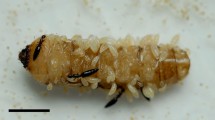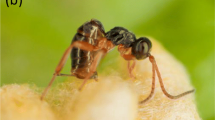Summary.
We studied the life history and social biology of two haplodiploid eusocial gall-inducing thrips, Oncothrips waterhousei and O. habrus. Both species have alternating generations of non-dispersing, micropteran soldiers and macropteran dispersers. A single female induces a gall, and produces all of the soldiers, which are protogynous and have an overall female-biased sex ratio in both species. The soldiers sibmate and collectively produce about 80% and 50% of the dispersing generation in O. waterhousei and O. habrus, respectively. On a per capita basis soldiers produce about 0.47 and 0.15 the number of dispersers of the foundress in O. waterhousei and O. habrus, respectively. The dispersers have an unbiased sex ratio in both species, but sibmating and local mate competition between soldiers suggests that these sex ratios are not a result of panmictic conditions. A comparison of the proportion of the gall occupied by brood in O. waterhousei and another eusocial galling thrips, Kladothrips hamiltoni, suggests that local resource competition is higher in K. hamiltoni, which might partly explain the lack of sex ratio bias in soldiers of the latter species.
Similar content being viewed by others
Author information
Authors and Affiliations
Additional information
Received 19 July 2001; revised 5 March 2001; accepted 22 March 2001.
Rights and permissions
About this article
Cite this article
Kranz, B., Chapman, T., Crespi, B. et al. Social biology and sex ratios in the gall-inducing thrips, Oncothrips waterhousei and Oncothrips habrus. Insectes soc. 48, 315–323 (2001). https://doi.org/10.1007/PL00001783
Issue Date:
DOI: https://doi.org/10.1007/PL00001783




